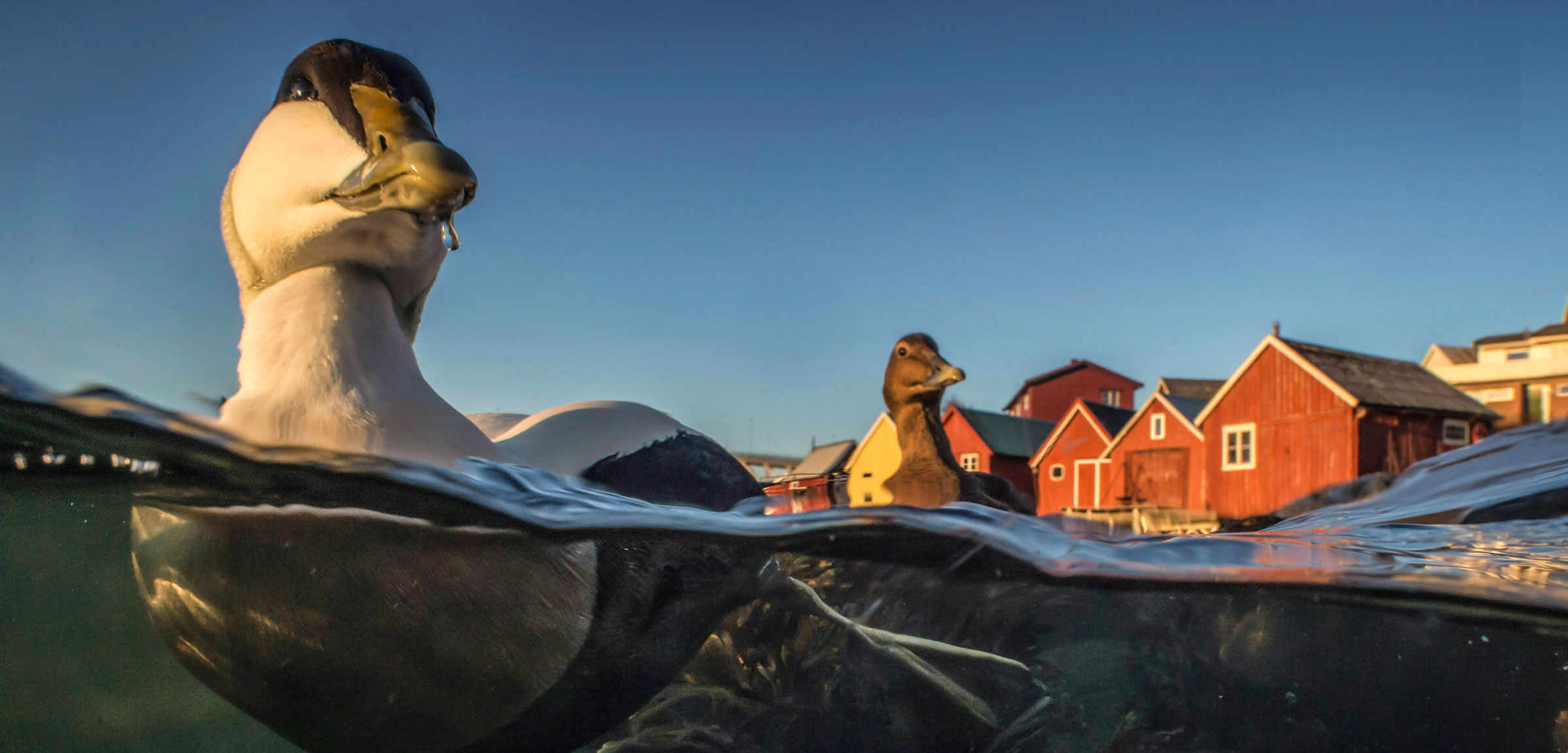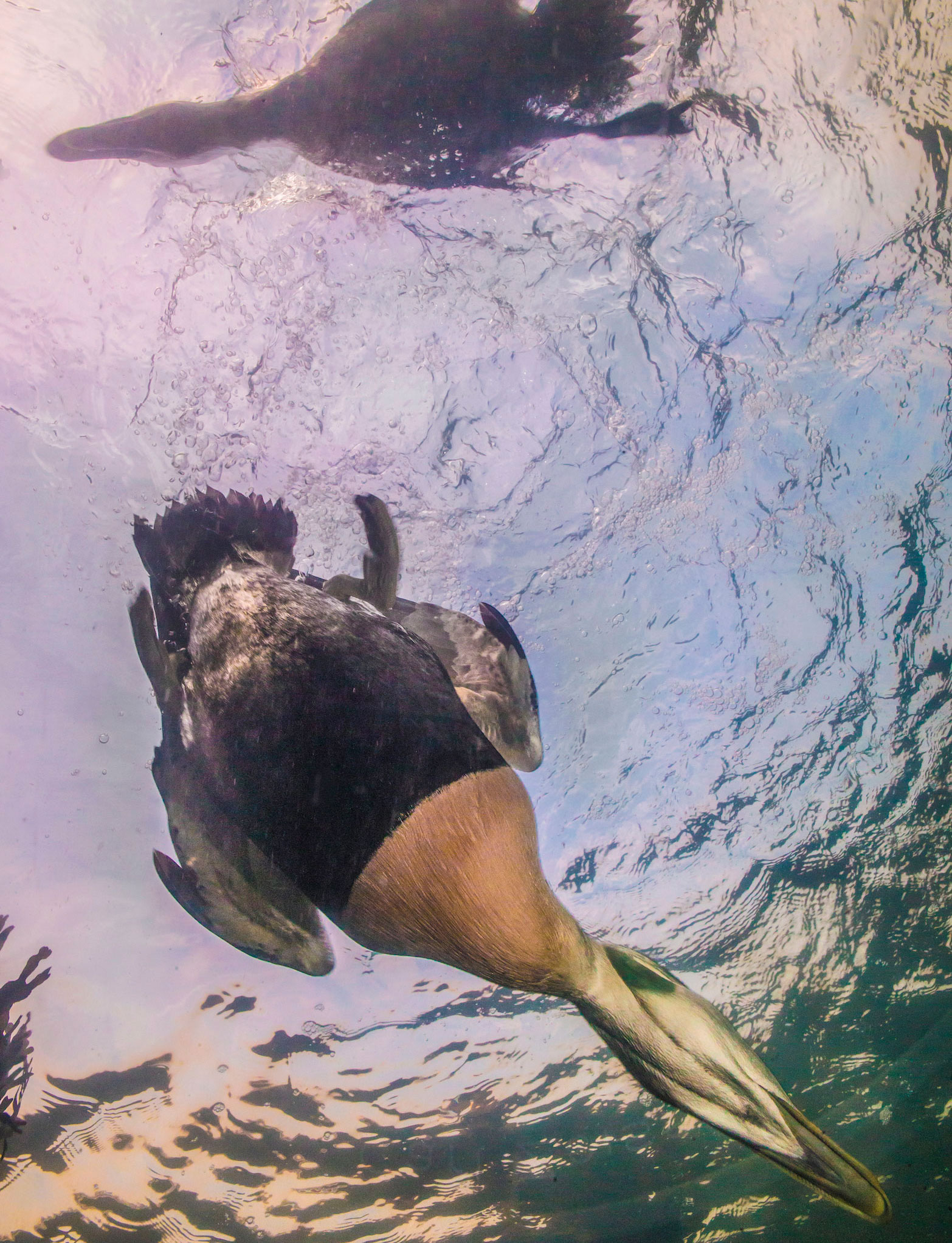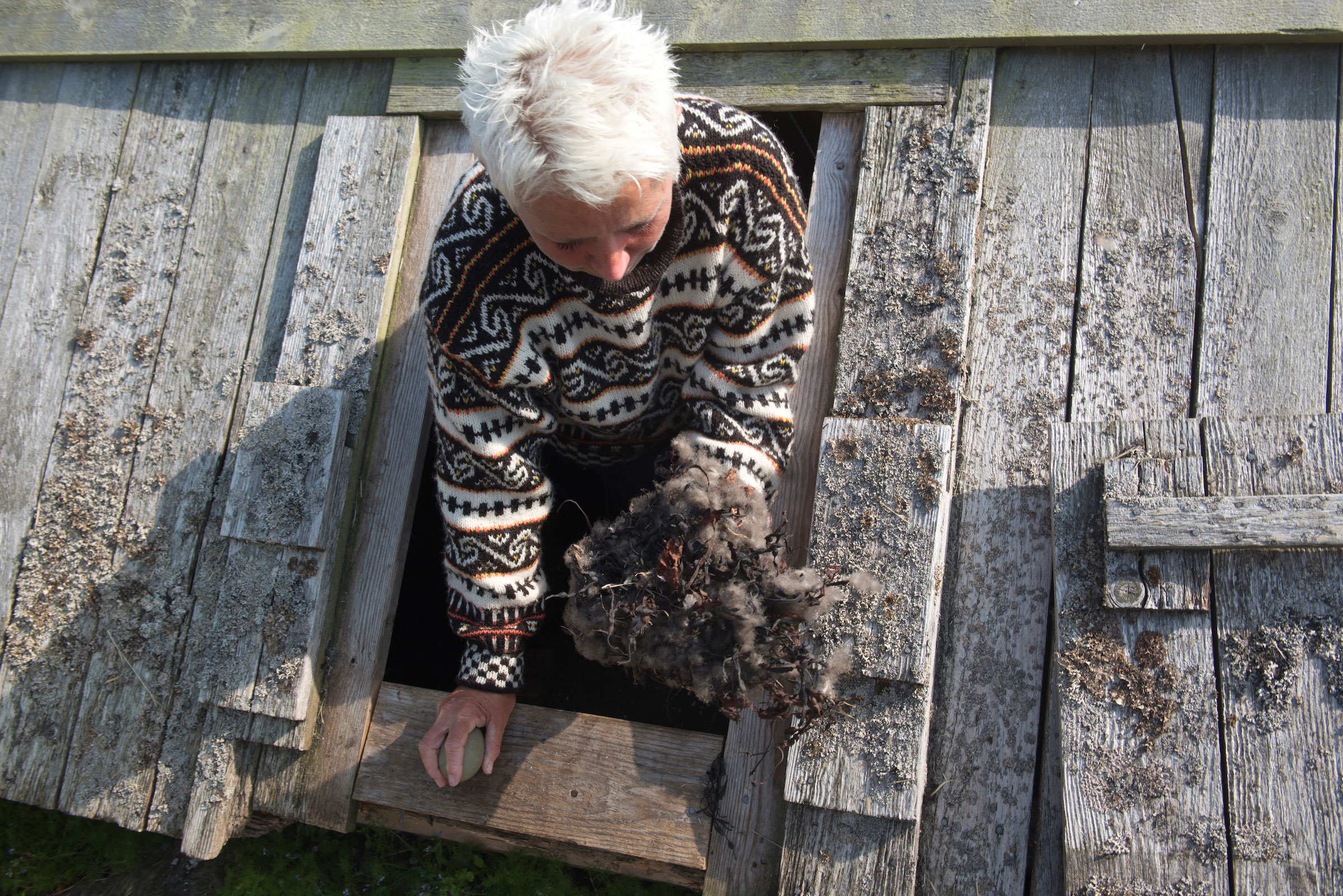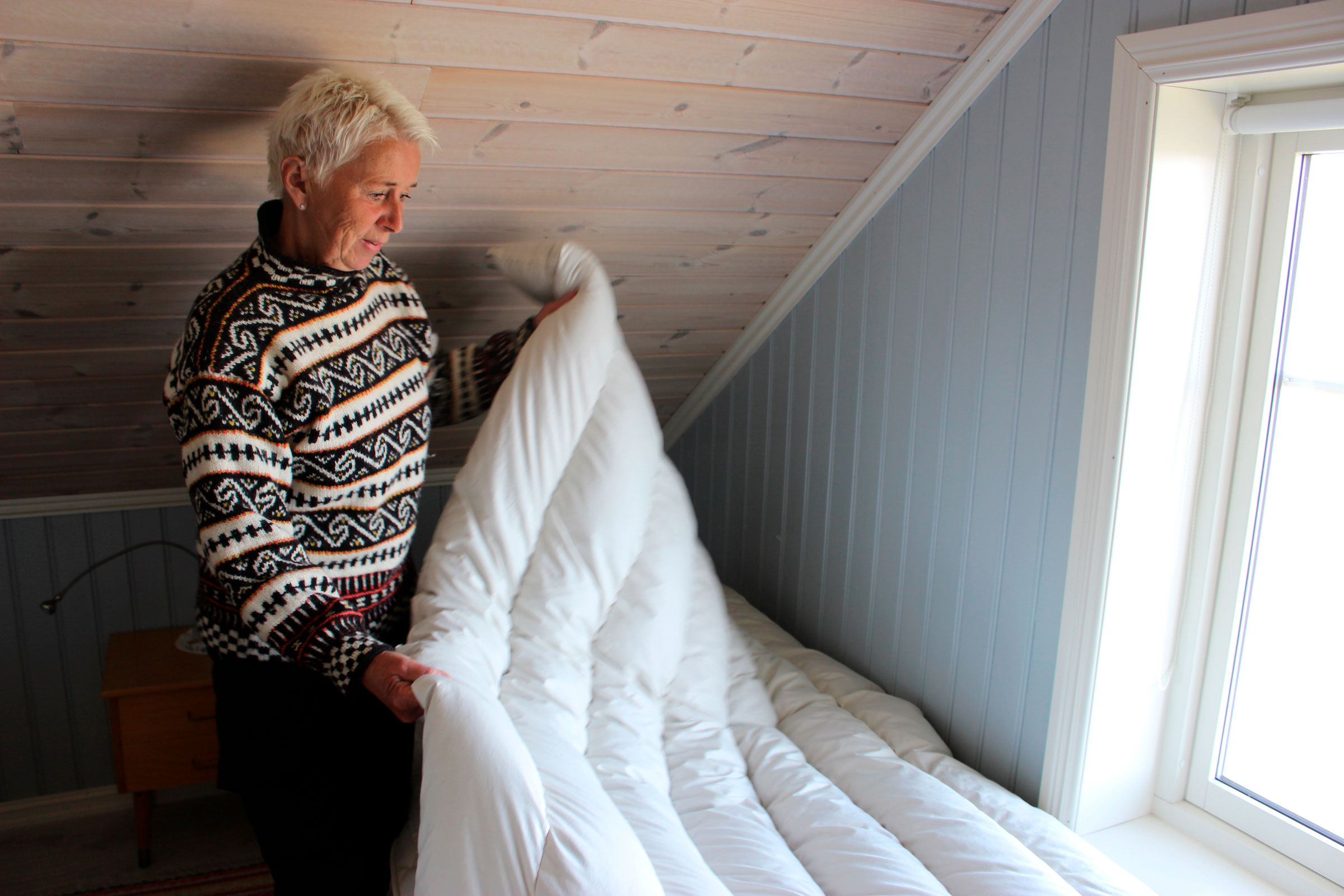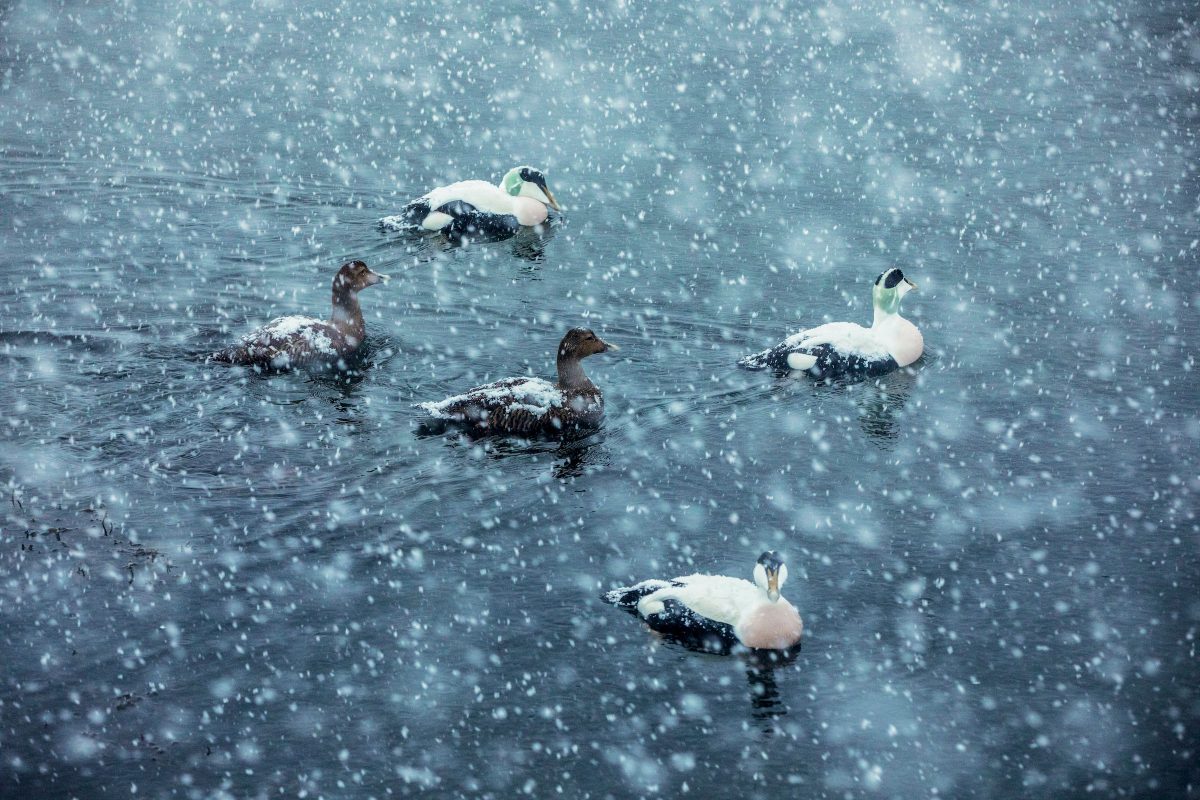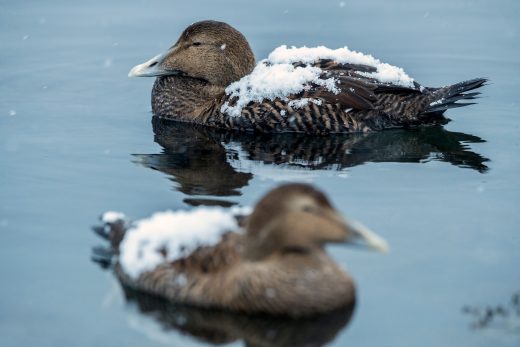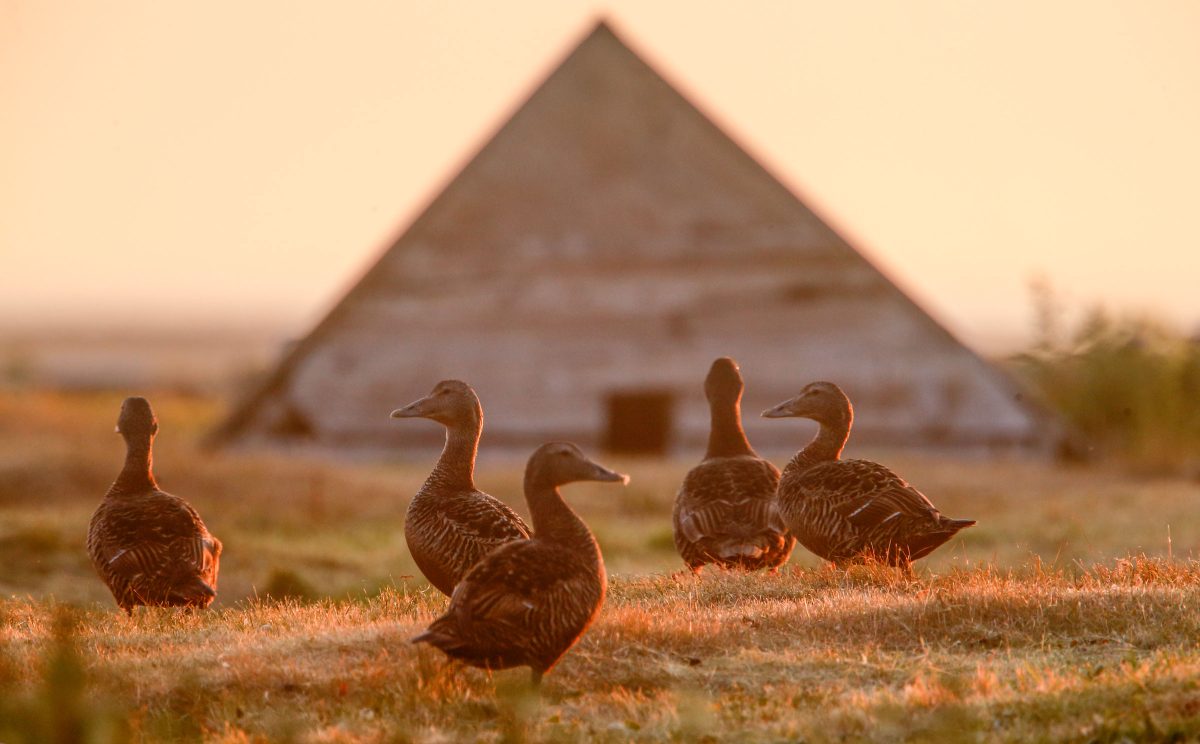The Eider Keepers
An age-old tradition in Norway illuminates the bonds between wild ducks, wild places, and the people who care for both.
Article body copy
This story originally appeared in bioGraphic, an independent magazine about nature and regeneration powered by the California Academy of Sciences.
Albert Stensholm made a frantic gesture toward his kitchen window, and I turned to see a plain brown duck ferrying her young across the channel separating Stensholm’s island from his neighbor’s. Above the small flotilla, a squabble of gulls circled, and then several dipped, looking to gulp down a duckling. Like a defensive cobra, the mother hoisted herself as if to strike. What happened next was a frenzied flapping, until, somehow, the ducklings darted past unharmed.
This mini drama played out in a matter of seconds, and when I turned back toward Stensholm, he looked shaken. A duckling snatched by a hungry gull might seem no more than a brutal reality of nature, but to this 57-year-old Norwegian, the common eider (Somateria mollissima) is a beloved friend. When I met Stensholm in mid-June on a remote island in the Hysvær cluster of the Vega Archipelago, where he lives for part of the year, he was guarding 67 eider nests, trying to protect the mothers and their offspring from predators like gulls, as well as mink, otters, and sea eagles. Like all wild birds, eiders can survive without human assistance. But across much of their range—including Iceland, Greenland, Alaska, northern Russia, and Canada—humans and common eiders have forged a unique, mutualistic bond. In Vega in particular, research suggests that a 400-year-old relationship between eiders and caretakers such as Stensholm leads to higher survival rates and more stable populations for the seabirds.
Located just south of the Arctic Circle, off the Helgeland coast in the Norwegian Sea, the Vega Archipelago consists of 6,500 islands, islets, and skerries. Satellite to the main island of Vega are constellations of outer islands—wind-raked and treeless, with an alpine feel. Across the heather moors, vegetation crouches low to the ground. Map lichen, typically found in the mountains, paints sea-level moraines with dabs of lime green. Isolated and exposed to the northern elements, Vega seems a harsh, inhospitable seascape—except that here, nestled amid bushels of kelp, lies a treasure long coveted by Norwegian coastal communities: unfathomably soft eiderdown.
Each spring, female eiders return to these islands from their wintering grounds. They lay three to six olive-green eggs apiece and insulate them with downy feathers they pluck from their own breasts. During the nesting season from May to July, the 50 or so people in Vega who still practice the “bird keeper” tradition voyage to the archipelago’s remote outer islands—many of which have been handed down through families for generations—to take up temporary residence. The bird keepers build houses and nests for the eiders and watch over them for months. When the ducklings fledge and the eiders abandon their nests at the end of the season, bird keepers collect the fluffy down they leave behind.
Female eider ducks lay three to six eggs, which they insulate with their own down. Hildegunn Nordum, pictured collecting down and with a down duvet sewn by her mother, is one of the 50 or so people in Norway’s Vega Archipelago who still practice the tradition of tending to eider ducks each spring.
Eiderdown is some of the softest down on the planet and is so lightweight it doesn’t register even when a watermelon-sized ball of it drops into a cupped palm. (The Latin species name for the common eider, mollissima, comes from mollissimus, which translates to “the softest.”) In Norway, people historically used this valuable resource as currency to pay rent to wealthy landowners. Even today, duvets stuffed with Vega’s cruelty-free eiderdown start at around US $8,000 each and last 50 years or more before beginning to molder.
Still, it’s tough to earn a living from the kind of small-scale eider tending practiced in Vega, which means the reasons for the tradition’s persistence into the 21st century transcend financial gain. Stensholm, for instance, doesn’t sell his down. He collects only enough each season to make a single duvet, which his sister sews as a gift for a newborn in their family.
I visited Vega hoping to understand what drives someone like Stensholm to spend up to six months each year living mostly alone, without running water or electricity, on a sliver of ice-scoured strandflat at the top of the world. In a time when so many stories about humans and wild animals are about harm, habitat loss, or extinction, I wanted to witness an example of the ways humans and wild animals can not only coexist but benefit from one another. I wanted to see how a grown man’s heart could break over a duckling, not because he hoped to turn a profit but because he had inherited a legacy of love.
Tall and broad shouldered, Albert Stensholm has the look of a Viking, and years of hand-rolled cigarettes have yellowed his pearly beard. On first impression, he struck me as someone who might wrestle a sea serpent and win. But as Stensholm showed me how to clean the down, he moved with practiced gentleness, a kind of understated expertise that matches the slow pace of life on these outer islands. Unlike eider tenders in Iceland, who have mechanized the process, Vega’s bird keepers clean their eiderdown by hand. First Stensholm picked out larger pieces of detritus, the barbules of each tuft clinging to bits of shell and kelp like the arms of a tiny octopus. Later he would remove smaller sediment by working the down through a harplike tool in a motion akin to scrubbing clothes on a washboard. Stensholm’s occupied nests would net him 550 grams of down, requiring around three weeks to clean.
Three times a day, Stensholm made rounds to check on the 170 nests he had built to see if empty nests had gained occupants and to monitor ducks already brooding. During my visit in June, he led me around the island, pausing to coo and cluck into the entrances of the duck houses of some of his favorite residents, which return to the same nests each year. His voice rose a few octaves as he told the brooding females how lovely they looked.
An eider, Stensholm told me, “is the most beautiful bird in the world.”
First photo: Male eider ducks are known for their striking coloration, including the electric green plumage on their cheek and nape. Second photo: Female eider ducks have mottled, dull-brown coloration, which helps them blend in with the coastal terrain while they incubate their eggs. Like their male counterparts, female eiders also have substantial fat reserves and a low metabolism, which help them survive in the northern cold.
The male common eider is indeed elegant. “The drake in breeding plumage is a superb creation,” wrote naturalist Gavin Maxwell in 1968, with a “scintillating electric green” on his nape and cheek. The male has a white silhouette, accentuated with a soft peach breast, and stately black feathers that sweep over his head, tail, and underside.
In comparison, the female is unremarkable, with mottled, dull-brown feathers. Advantageously, she resembles a pile of washed-up kelp, which allows her to blend in with her surroundings. Both female and male are heavyset and huge. The common eider is the largest of all sea ducks in the northern hemisphere, lying “betwixt the Goose and the Duck” in size, according to one account from 1755. They are not strong fliers.
Yet the eider’s substantial fat reserves and low metabolism help it survive the northern cold. The birds primarily eat blue mussels, along with urchins, scallops, sea stars, clams, and periwinkles. When shallow waters aren’t accessible, they can dive up to 40 meters to reach mussel beds. Producing a silver plume of air bubbles in its wake, an eider propels itself with forceful wing strokes to pry a single mussel from the seafloor. Back on the water’s surface, it swallows the mollusk whole, its muscular stomach crushing shells with the aid of small stones ingested in advance. By the end of a day, an eider can have guzzled its own weight in food, only resting to digest between meals.
Historically, Vega’s female bird keepers passed down knowledge about the lives and habits of eiders; the men of Vega ventured to sea to fish while women stayed behind to manage the ducks. Today, only half of the archipelago’s 22 keepers are women, including Vibeke Steinsholm, who nearly shares a last name with her cousin Albert Stensholm. [Editors note: to avoid confusion, we’re using each person’s first name for the remainder of the story.]

A male eider duck surfaces after a dive off the coast of Straumen. Eider ducks can dive 40 meters to feed on mussel beds on the seafloor.
I met Vibeke on Albert’s island, though she tends eiders on her own island in Hysvær, a short rowboat trip away. A fifth-generation bird keeper, Vibeke learned this way of life from her grandmother. Put another way, she learned her grandmother’s particular style of bird keeping, since each caretaker cultivates their own idiosyncrasies. Her grandmother, for example, liked to sing to the mother ducks. Sometimes she even wanted to be alone to commune with the birds, convinced they didn’t want to “talk” to anyone but her. A woman on another island moved in with her next-door neighbor when eiders nested under her house to avoid disturbing the birds.
Vibeke continues the tradition; she taught her youngest son to build an eider nest out of dried fucus seaweed by the time he was six. There’s no one way to build an eider nest, just as there’s no manual for building the “house” that bird keepers construct to shelter each nest. People fashion them from flotsam, driftwood, stones, and overturned boats, and one lucky duck each season gets to nest in an old cauldron. Many of the houses are dollhouse sized, giving the landscape the look of a Lilliputian coastal village. Some mimic the neat timber-frame style of Norse architecture, while others, to the untrained eye, look more like the jumbled wreckage of whatever the tide shoved ashore that day. Yet despite the haphazardness, understanding what makes an appealing eider house is a fine-tuned blend of generational knowledge and a person’s own observations. “You have to see, you have to listen, you have to be in contact with this place,” Vibeke said. “You have to use your senses. Year after year, you find out more.”

Bird keepers construct eider houses using a variety of materials, from flotsam and driftwood to overturned boats.
Aboard the Black Pearl, I gripped the bottom of my seat, bracing myself as we hurtled out to sea to visit another group of islands called Lånan. My gloved hands began to go numb from cold, even though it was mid-June. Albert and Vibeke, who had hitched a ride, relaxed in the bow—no hats, no gloves—chatting animatedly. Albert had never visited the neighboring island cluster and was eager to learn from its eider tenders.
After 40 minutes, we reached Lånan, home to the largest eiderdown operation in the archipelago. The boat captain throttled down the motor to avoid startling the eiders. For up to half the year, five families live off the grid here, collecting rainwater like their ancestors did and running power off solar batteries and generators. Each April, they prepare approximately 1,000 nests.
Hildegunn Nordum grew up on Lånan. Her ancestors settled there in the mid-1850s, and by the 1950s, the village practically bustled with a population of around 50 residents. With short cropped hair, Nordum is a trim, agile 67, and doesn’t shy away from the more physically demanding aspects of bird keeping. When predators breach an eider colony, Eurasian oystercatchers sound the alarm in high-pitched squeaks, signaling to bird keepers to come to the eiders’ defense. Nordum said she sometimes scares winged predators away by raising a two-by-four over her head and bringing it down against her deck, mimicking the crack of a gun. She also holds a pillow in each hand and flaps her arms like wings. The eagles are big, Nordum said, “but I’m the bigger bird.”

Gulls and crows often prey on eider duck eggs, which makes the nesting season a busy one for the bird keepers of the Vega Archipelago. Photo by Devon Fredericksen
Other threats, however, advance despite bird keepers’ vigilance. Across Norway, seabird populations are plunging, with pelagic species like the black-headed gull, common murre, and the Atlantic puffin listed as endangered or critically endangered. Common eiders are no exception. Between 1986 and 2013, the common eider population in Norway declined from approximately 112,000 breeding pairs to 88,000 breeding pairs. Over the last three eider generations, scientists estimate the overall population in Norway has declined by some 30 to 35 percent, leading the country in 2021 to list the species as “vulnerable,” a more at-risk category than its 2015 listing as “near threatened.”
Sveinn Are Hanssen, a senior research scientist at the Norwegian Institute for Nature Research, said one eider colony he’s been studying for almost 30 years near Tromsø is at risk of disappearing. Fewer than 150 females now reproduce there, down from around 600 in 1995. Although the problem is too complex to pinpoint a single culprit, studies show a negative trend in eider populations with climate change, likely due to related issues of disease and new predation threats, along with a compromised food chain. The blue mussel population, for example, has plummeted in the Norwegian Sea, with the possible causes ranging from climate change to a surge in predatory dog whelk snails.
“It’s really, really scary,” said Thomas Carlsen, a scientist with the Norwegian Institute of Bioeconomy Research. “It’s quieter now in the spring.”
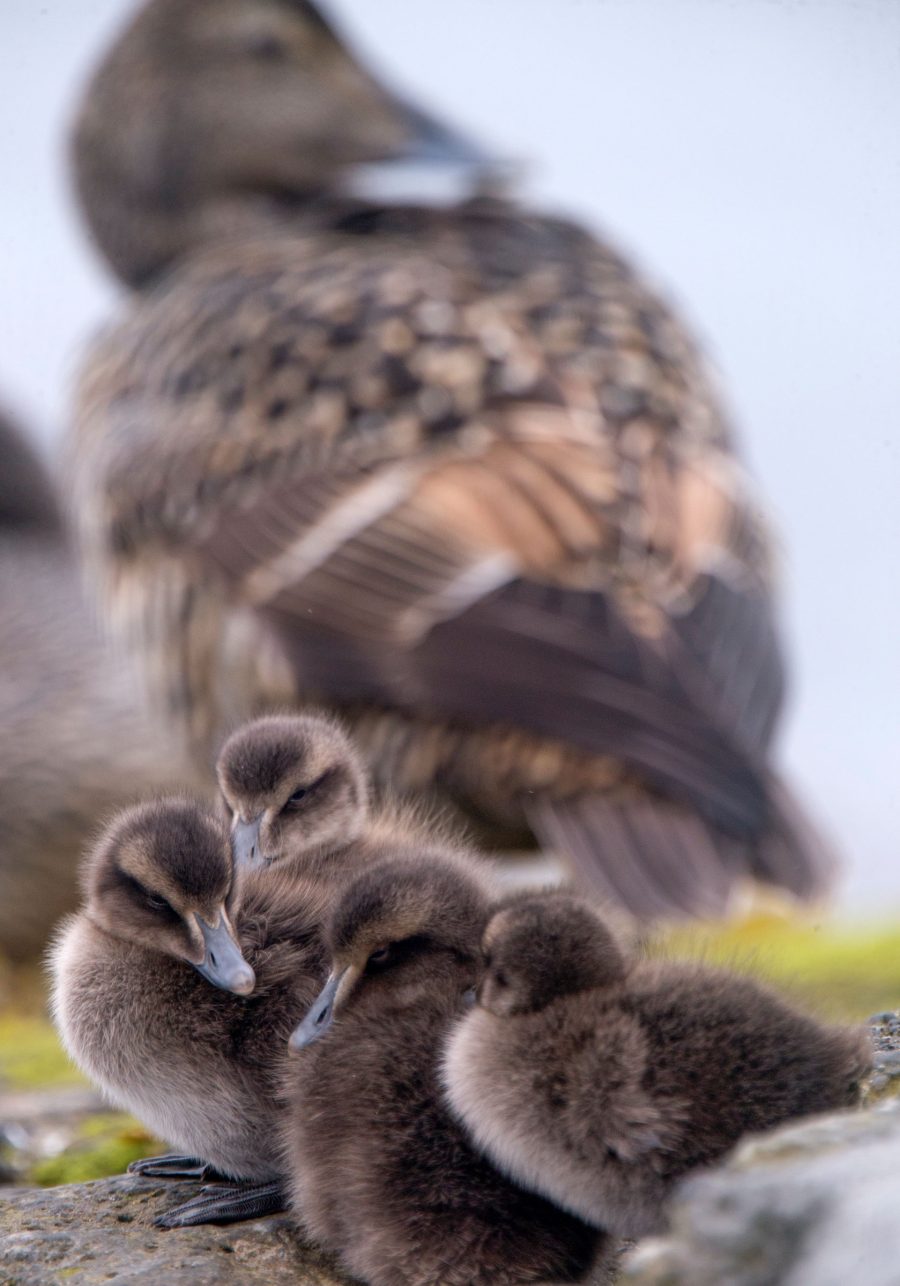
Although bird keepers continue to protect and support eiders along the Vega Archipelago, the ducks have nevertheless struggled to maintain their population. Scientists estimate that the overall eider duck population in Norway has declined by 30 to 35 percent over the birds’ past three generations.
While the number of nesting eiders in Vega has also decreased nearly every year since 2014, eiders there haven’t been hit as hard as in other areas of the country—and some scientists think bird keepers may have something to do with that. Data show that the eider population in Vega correlates with the ebb and flow of human migration in the archipelago. In 1900, the Vega municipality reached its peak human population of 2,891, and nesting eiders numbered around 7,000. After the Second World War, the federal government viewed Vega residents’ traditional, subsistence lifestyle as backward and incentivized small-scale farmers and fishermen to relocate to cities to work in the iron and aluminum industries. As people filtered out of Vega, infrastructure slumped, schools closed, and ferries ceased to run. By 1983, only 66 people remained. Without their human protectors to help fend off predators, the eiders also fared poorly, particularly after invasive minks escaped from surrounding mink farms and wreaked havoc on regional seabird populations in the 1980s and 1990s. By 2004, eider tenders reported fewer than 400 nesting females on their islands.
“They actually rely on the safety the humans give them,” Carlsen said. “It’s a strange and unique connection. A [wild] animal directly connected to humans.”
In her book, A Wild Bird and a Cultured Man, Alexandra Goryashko covers the extensive history of the eider-human relationship, which has not only lasted at least 14 centuries but has arisen independently in various northern cultures, from the Chukchi of Russia to the Inuit of Greenland. Now people are using that relationship to help with eider conservation. In response to disrupted ocean currents and sea ice accumulation, for instance, Inuit people in the Belcher Islands in Hudson Bay, Canada, venture into the subzero chill to manually break up ice that sometimes crusts over polynyas—pockets of open seawater—so the birds can feed through the winter. The common eider has so thoroughly nested itself at the heart of culture that humans sacrifice their own comfort for the birds’.

A flock of eider ducks takes off. While the ducks aren’t known to be strong fliers, they are exceptional divers, venturing deep under the surface to prey on mussels and clams.
For a time, the story of Vega’s eiders was looking up. In 2004, Vega secured UNESCO World Heritage status, and tourism jumped tenfold. Bird keeper numbers rose again, and the ducks rebounded. With the resurgence of the duck tending tradition, the eider population in Vega increased to 1,647 nesting females by 2014. A 2013 study coauthored by Hanssen showed that human intervention—with people actively limiting predation—improves eiders’ reproductive success. When predators were driven away from one eider colony, the population growth rate was higher than in a control colony in a nature reserve that lacked human interference.
Still, likely because of the changing climate, the Vega eider population has dropped by 37 percent in the past decade.
“The oldest tenders have an ecological sorrow,” Vibeke said. “The decline is very obvious, because they can compare it to when the islands were stuffed with all kinds of birds.”
The numbers are so concerning that, for years, Rita Johansen, Vega’s UNESCO site coordinator and the managing director of the World Heritage Foundation, has urged the government to fund scientific studies to better understand the causes of the decline and the potential ecological consequences. What’s needed is not only an examination of the food supply, she said, but also of predation, invasive species, diseases, parasites—and how everything connects to everything else. Of course, these kinds of holistic, coordinated efforts are invariably more difficult to fund.
The other problem, Johansen said, is the lack of communication between some of the government agencies that handle environmental issues. “They are sitting in silos and don’t cooperate in between,” she said. This creates bottlenecks on both the federal and local level. While the birds and their custodians have been living symbiotically for hundreds of years, in other words, humans are still figuring out how to work with other humans. This can even be a problem among bird keepers. Though the federal government gives each bird keeper a stipend of roughly US $5,000 to cover expenses for tending, an undercurrent of capitalistic competitiveness still runs through the culture.
“I don’t know how many birds the neighbor has,” Albert said. Every year he inquires, but his neighbor to the north withholds his count. “It’s an old thing,” Albert said—a generational anxiety stemming from a time when sales from eiderdown could amount to half a family’s annual income.
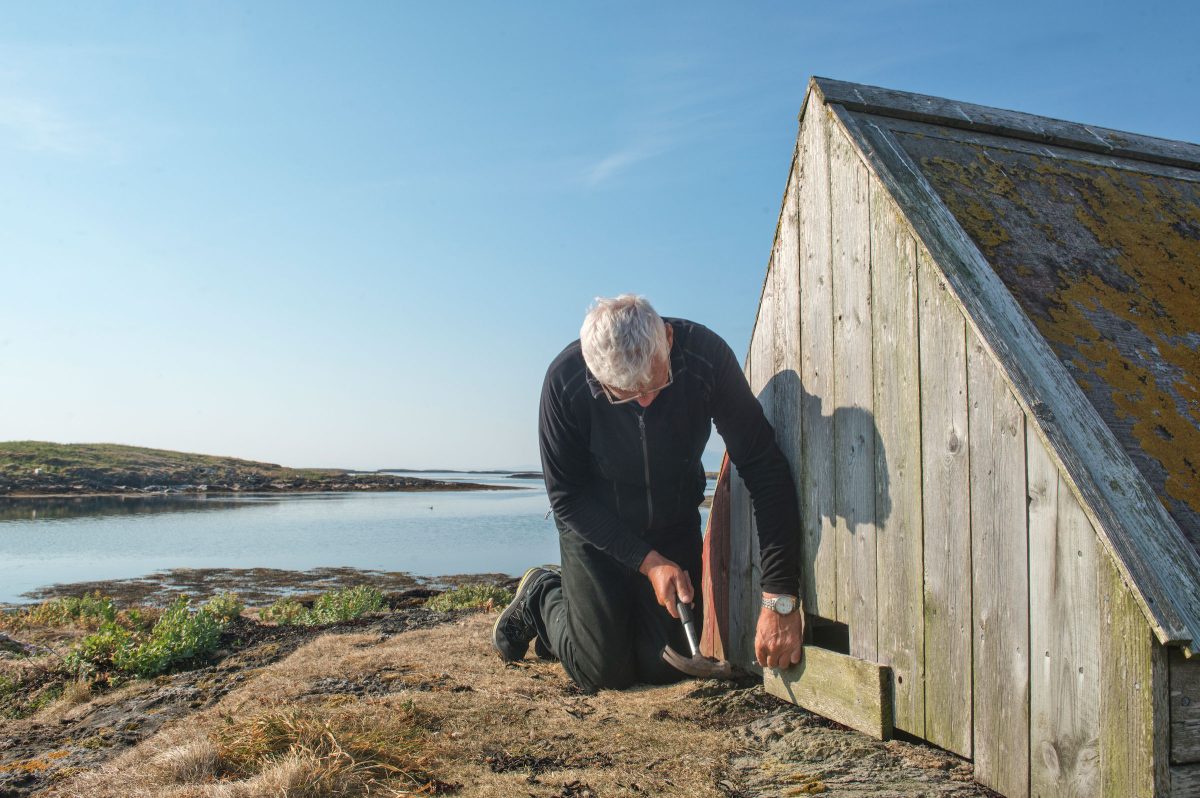
While bird keeping is a tradition primarily upheld by women in Norway, men are often involved in the maintenance and repair of eider houses between nesting seasons.
In some cases, rivalries have turned nearly Shakespearean. Before they fell in love and married, Albert’s parents lived on neighboring islands. One year, his mother’s family counted 100 eiders. On his father’s island, the count was 101, which the family gloated about for years to come. Telling this story, Albert laughed and shook his head. Though he assured me the ongoing competition between the families was all in good fun, he described the feud as an “eider war.”
Today communication among tenders is largely limited to a biannual meeting at the UNESCO World Heritage Center, and to some extent over social media. Yet even during the meetings, said Vibeke, people aren’t quick to disclose their strategies for success, nor are they receptive to new ideas.
But the competitive attitudes may be shifting as some bird keepers consider how sharing strategies and information might benefit not only the tenders, but also the birds themselves. On Lånan, I followed Albert, Vibeke, and Nordum as they walked along a path lined with marsh marigolds. They discussed the effectiveness of seaweed piled atop eider houses as insulation, the advantages of east- and north-facing entrances, and the pros and cons of two-entrance houses (a second opening can be an escape route from harm but can also serve as another entry point for predators). Albert joked about how the houses he builds have grown in size over the years. Nordum affirmed that some of the eiders seem to prefer to cohabit in mansion-scale duck real estate. Listening to the three of them exchange knowledge, I wondered whether I was witnessing the genesis of something more enduring than coordinated conservation efforts. By the end of our visit, everyone was hugging.
On her island, in a creaky old house inherited from her aunt, Vibeke and I shared a dinner of fresh-caught fish, boiled potatoes, and fried sugar kelp. The midsummer evening sun streamed through the window, flushing Vibeke’s cheeks a rosy gold. Even when she’s not gilded with low-angled light, she radiates a youthfulness that belies her 58 years. In the moments between duck tending, she chops wood, harvests shellfish and kelp, cultivates native medicinal plants, and pulls buckets of water from a well located below a slat in her living room floor. To curb the younger generations’ waning interest in such a labor-intensive, unlucrative lifestyle, Vibeke teaches schoolchildren from the main island about the joys of living close to the land.
“This tradition, I hope it’s not dying,” Vibeke said, “but if it should survive, it’s maybe not possible to go the traditional way.” The old way was an inherited literacy, passed down to women only, and confined to bird-keeping families. Now the eider’s persistence might depend on enlisting a wider range of stewards.
“Not everyone can take time off from April to August without a fixed salary,” Nordum had pointed out earlier. Recognizing this, the World Heritage Foundation recently bought an island with a yellow house where they hope to start a school to train students to assist bird keepers at the end of each school year. Additionally, Vibeke, Johansen, and others have been organizing the “Sound of Silence,” a symposium scheduled for April 2024, to celebrate the 20th anniversary of UNESCO World Heritage inscription. They want to bring together politicians, artists, scientists, and stewards to discuss integrated ways of addressing the seabird decline and to put the issue on the national agenda. They want to make clear that the bird-keeping tradition isn’t some vestige of an outdated way of life, but an example of how to build a more sustainable future.
“This is a good message for our time,” Vibeke said. “That you can cooperate with nature in a way that doesn’t destroy it or take too much.”
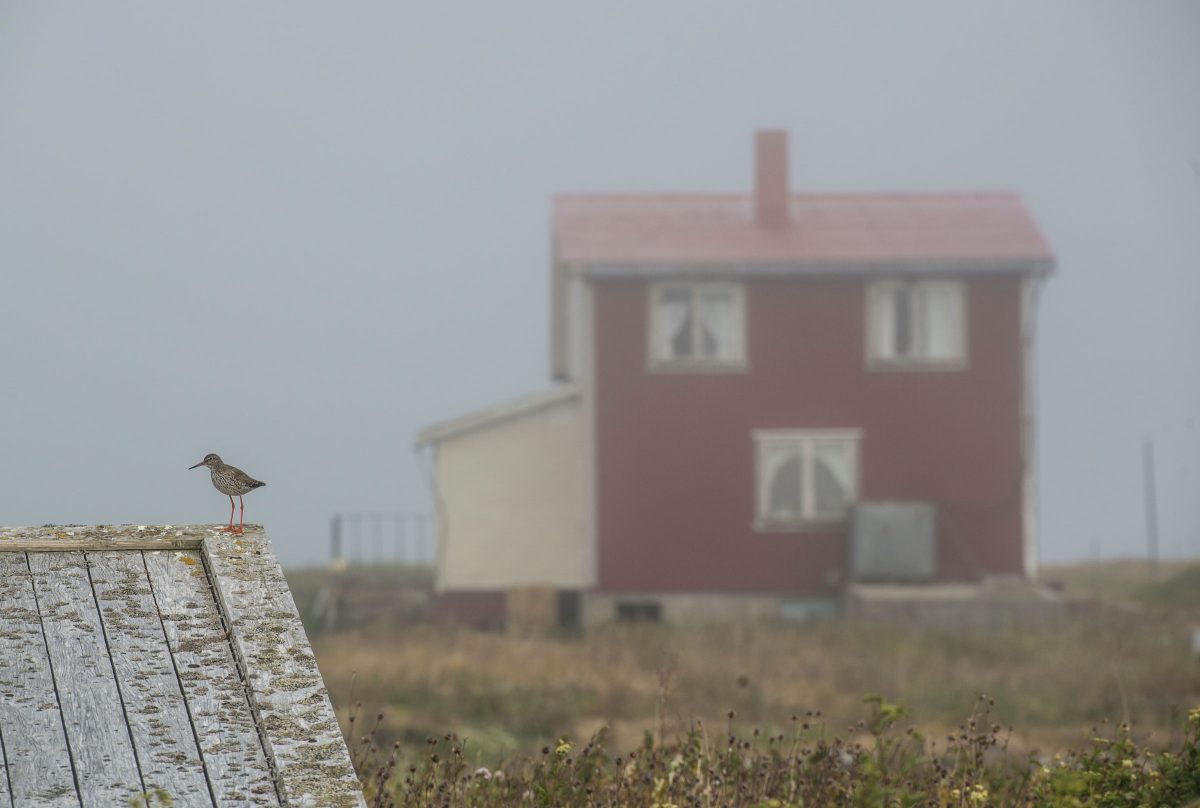
On the foggy island of Lånan, in the Vega Archipelago, humans and eider ducks coexist with other local species, such as this redshank resting atop an eider hut.
One morning during my visit to Vega, Albert sat on his dock fixing bait onto a halibut hook. Glancing up, he saw more than a dozen adult eiders gliding through the water, shuttling five fledglings across the channel. Then, to his horror, a nearby gull snatched up a duckling and returned to pick off a second. Albert was too far away to intervene, so all he could do was yell.
He texted Vibeke to relay the “terrible act.” When I met up with Albert later that day, I asked him about it.
“I know it’s the circle of life,” he said, “but this is a very sad story.”
The eiders, after all, are like kin. He’s even named many of them after his human family members.
Nordum had expressed a similar sentiment. “Our family has always loved the eider,” she told me. “It’s a big love.”
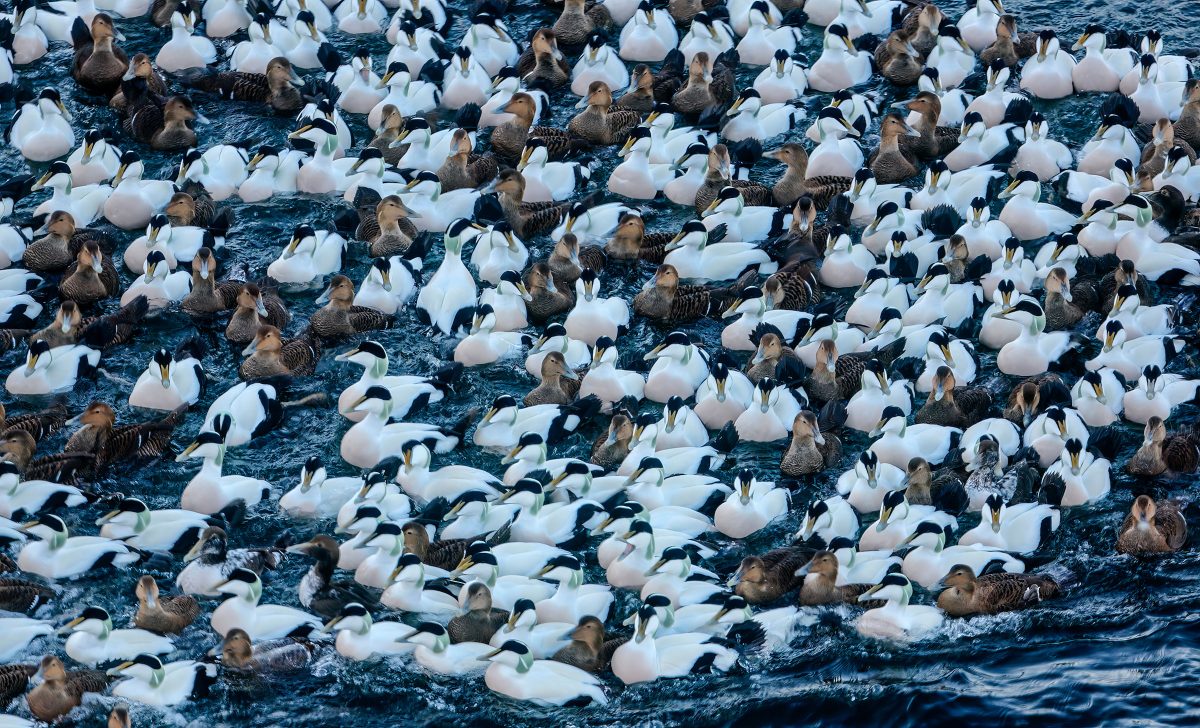
When threatened, eider ducks gather in a dense flock to protect themselves. These birds were reacting to the presence of an otter.
Given that most of the tenders no longer rely on eiders for subsistence or paying rent, love may be the most genuine reason to explain their continued engagement. In this sense, even to call the relationship mutualistic may be too clinical, falling short of capturing the true meaning people derive from their work.
Some scientists argue that if bird keepers discontinued the tradition, eiders would simply revert to wild nesting sites. Still, without the human contribution, something would be lost. For the bird keepers of Vega, to relinquish their role would mean disengaging from their history, their families, their place in the world—the whole elemental, ancient experience that binds them to the land, to the sea, and to one particular species of wild bird. Within this fragile, far-flung ecosystem, eiders are vital. And because of an unbroken, evolving commitment, so too are humans.

